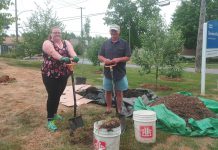
With the return of longer, warmer days, we’re all spending more time outside. Now is the time many are getting an early start on cleaning up garden beds and raking the yard. I spent the entirety of a recent afternoon dealing with branches, breaking them into smaller pieces and bundling them up for collection. Garden clean-up aside, a task that needs to be completed in the coming weeks is setting up composters for the year ahead.
For those new to composting, getting started is easier than you might think. The first and most obvious tool you’ll need is a composter. These can be obtained from the GreenUP Store and most hardware stores and garden centres. Composters and kitchen catchers are available for county residents to purchase at the Public Works office on Armour Road.
Once you have your composter, you need to choose an appropriate place to put it. Location is important, as it plays a role in how well the contents of your composter break down. Put your composter in a location that is easy for you to access, close to a water supply, and in a location that will see plenty of sunlight. A well-drained location is the best choice.
Once you have your composter and have it set up, it’s time to start using it. When you add material to your composter for the first time, you need to think layers.
Compost can be separated into two types: greens and browns. Greens include kitchen scraps like peelings, fruit scraps, and grass clippings. Browns can include items like coffee grounds, wood shavings, and hay. Creating alternating thin layers of each will ensure a balance of the nutrients you need so that the compost process works efficiently.
Avoid putting items like meat, fish, bones, fatty foods, and dairy products into your composter. These items will eventually break down, but cause odours that can attract raccoons, rats and mice — all creatures we don’t want in our backyards. Cat and dog waste, diseased plants, or plants with mature seeds should also be left out.
Moisture and air play important roles in the composting process. There should be just enough water in the compost so that if you pick a handful up and squeeze it, a few drops come out. Once the hot and dry weather arrives in the summer months, adding water may be necessary to ensure the compost process continues.
If you find too much water is a problem, add drier materials, aerate, or leave the lid off during dry sunny days so moisture will evaporate. Turning the compost every few weeks will ensure enough air is reaching the innermost material.

While we all want access to the black gold developing inside, it’s important not to rush the composting process. Depending on how the composter is managed, the process can take anywhere from a few months to a year to obtain garden-ready compost.
If you add large, unchopped materials, the composting process can take even longer. Large quantities of yard waste are best left out for collection if possible. Within the city, green waste collection started on Tuesday, April 7th. You’re asked to put your green waste in paper yard waste bags, bushel baskets or garbage containers with a “green waste” sticker clearly visible. If you need stickers, they’re available for free at the GreenUP Store. Unlimited amounts of green waste can be put out for collection.
Leaf and yard waste collection is also available in some Peterborough County communities; visit the County’s website at county.peterborough.on.ca for full information.
If you don’t want to wait for the process to finish in your home composter, GreenUP Ecology Park sells finished compost by the bucket. Sales start on Friday, May 8th from 10 a.m. to 4 p.m. You’re asked to bring containers to load and carry your black gold home.
Composting is a great way to not only give our gardens the gift of a rich and nourishing addition to the soil, but also to reduce our waste. There’s no better time to start composting than the spring — so make an effort in the coming weeks to set up your own backyard composter.


























